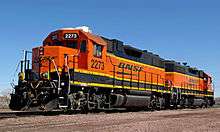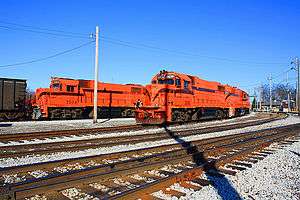EMD GP38-2
| EMD GP38-2 | |||||||||||||||||||||||||||
|---|---|---|---|---|---|---|---|---|---|---|---|---|---|---|---|---|---|---|---|---|---|---|---|---|---|---|---|
|
South Shore Line GP38-2s idle near the Michigan City shops. | |||||||||||||||||||||||||||
| |||||||||||||||||||||||||||
| |||||||||||||||||||||||||||
| |||||||||||||||||||||||||||
| |||||||||||||||||||||||||||
The EMD GP38-2 is a four-axle diesel-electric locomotive of the road switcher type built by General Motors, Electro-Motive Division. Part of the EMD Dash 2 line, the GP38-2 was an upgraded version of the earlier GP38. Power is provided by an EMD 645E 16-cylinder engine, which generates 2000 horsepower (1.5 MW).[1] Most built still remain in service in the modern era due to ease of maintenance and exceptional reliability.
Spotting features
The GP38-2 differs externally from the earlier GP38 only in minor details. Its most distinctive identifying feature is the cooling water level sight glass on the right side of the long hood. The battery box covers of the Dash 2s are bolted down instead of hinged. It can be distinguished from the contemporary GP39-2 and GP40-2 in that its Roots blown engine had two exhaust stacks, one on each side of the dynamic brake fan, if equipped, while the turbocharged GP39-2 and GP40-2 has a single stack. The GP39-2 has two radiator fans on the rear of the long hood like the GP38-2, while the GP40-2 has three. It was also available with either a high-short-hood, common on Norfolk Southern units, or a low-short-hood, which is found on most other railroads.
- NS #5356 (Low short hood) at NS Botsford Yard. (Ex-Conrail)
 NS #5044 (High short hood) at NS Inman Yard. (Ex-Southern)
NS #5044 (High short hood) at NS Inman Yard. (Ex-Southern)- ONT #1806 at Huntsville, Ontario

GP38-2W

The GP38-2W is a Canadian variant of the GP38-2 and a forerunner of today's wide-nose units. It is easily distinguished by its wide-nose Canadian comfort cab. 51 of these locomotives were produced for Canadian National Railways during 1973–1974.
Although a W is commonly suffixed to the name, it is actually an addition by enthusiasts to help specify the presence of a CN-spec comfort cab. No locomotives built using CN's design of comfort cab ever featured a W in their designation, as the presence of the cab did not mechanically alter the locomotive. This is reflected by the lack of the "W" in the model designation on the builders' plates of these units.
There are snow shields above the inertial-filter central air intakes behind the cab; the electrical boxes and equipment blower behind the cab also differ in detail from a standard GP38-2. They are otherwise identical.[2]
Original buyers
1,799 examples of this locomotive model were built for American railroads and industrial concerns, 257 for Canadian railroads and industrials, 156 for Mexican railroads and industrials, and 1 export unit for the Saudi Government Railways. A total of 31 GP38-2s were built with high-short-hoods containing steam generators for passenger service on Mexican railways. In addition, all 257 of Southern Railway's GP38-2s had Southern's "standard" high-short-hoods.[3]
| Railroad | Quantity | Road numbers | Notes |
|---|---|---|---|
| Angelina and Neches River Railroad | | 2000 | |
| ARMCO | | B-84 | |
| Atlanta and West Point Rail Road | | 6007–6008 | Family Lines paint. To |
| Atlanta & St. Andrews Bay Railway | | 508–510 | |
| Belt Railway of Chicago | | 490–495 | |
| Boston & Maine Railroad | | 201–212 | 212 was renumbered 200 as a
bicentennial unit. |
| Burlington Northern Railroad | | 2078–2109, 2150–2154 | 2150-2154 assigned to Fort Worth & Denver. Most passed on to BNSF Railway. |
| Butte, Anaconda and Pacific Railway | | 108–109 | |
| Chicago & North Western Railway | | 4600–4634 | Ordered by Rock Island. To Union Pacific Railroad. |
| Chicago, South Shore & South Bend Railroad | | 2000–2009 | |
| Cleveland Electric Illuminating Co. | | 100–108 | |
| Clinchfield Railroad | | 6000-6006 | Family Lines paint. To Seaboard System. |
| Colorado and Wyoming Railway | | 2001–2002 | |
| Conrail | | 8163–8281 | All units were renumbered when divided between CSX Transportation |
| Curtis, Milburn & Eastern Railroad | | 810, 817-819 | |
| Detroit, Toledo & Ironton Railroad | | 221–228 | 228 was renumbered 1776 for
the bicentennial. Renumbered GTW 6221-6228 in 1984-85. |
| Durham and Southern Railway | | 2000–2003 | To Seaboard Coast Line Railroad 556-559. |
| Elgin, Joliet & Eastern Railway | | 700–704 | All to Birmingham and Southern Railroad. 703 re-purchased in the 90s and assigned to Waukegan. |
| Florida East Coast Railway | | 501–511 | |
| Georgia Railroad | | 6009-6010, 6051-6052 | Family Lines paint. To Seaboard System |
| Grand Trunk Western Railroad | | 5812–5836 | |
| Gulf, Mobile & Ohio Railroad | | 740–754 | To Illinois Central Gulf Railroad. |
| Illinois Central Gulf Railroad | | 9600–9639 | |
| Illinois Terminal Railroad | | 2001–2004 | |
| Kansas City Southern Railway | | 4000–4011 | |
| Lehigh Valley Railroad | | 314–325 | To the Delaware & Hudson Railway upon creation of Conrail as 7314-7325. Briefly renumbered to 220-231 during the Guilford ownership of the D&H, upon emergence from Guilford renumbered to 7303-7312. |
| Long Island Rail Road | | 250–277 | 261, 268, 270-271 to New York and Atlantic Railway.
Delivered in Long Island bicentennial scheme. |
| Louisville & Nashville Railroad | | 4050–4144, 6011-6044 | 6011-6044 Family Lines paint. To Seaboard System. |
| Milwaukee Road | | 350–365 | To Soo Line Railroad. |
| Mississippi Export Railroad | | 65–66 | |
| Missouri-Kansas-Texas Railroad | | 304–321 | 319-321 has D\B To Union Pacific. |
| Missouri Pacific Railroad | | 858–959, 2111–2237, 2290–2334 | To Union Pacific. |
| Penn Central Transportation | | 7940–8162 | To Conrail, same numbers. |
| Phelps Dodge Corporation | | 1–4, 9, 55, 56, 58 | |
| Pittsburgh & Lake Erie Railroad | | 2051–2056 | |
| Providence & Worcester Railroad | | 2006–2009 | |
| Public Service Co. of Indiana | | WG1-WG2 | Lettered for AMAX Coal. |
| Rock Island | | 4300–4355, 4368-4379 |
Acquired by GTW, MP and P&LE upon dissolution of Rock Island. |
| San Manuel Arizona Railroad | | 16–17 | |
| Seaboard Coast Line Railroad | | 500–555, 6045-6050, 6053-6065 | 6045-6050,
6053-6065 Family Lines paint. To Seaboard System. |
| Soo Line Railroad | | 790–799, 4410–4452 | 790–799 renumbered 4400–4409
soon after delivery. |
| South East Coal Co. | | 3821–3823 | |
| Southern Railway | | 5000–5256 | High-short-hoods. To Norfolk Southern. 23 rebuilt with an Admiral Cab. 50 to be sold at auction on August 18, 2016. 5076 sold to Northwestern Pacific in 2017. |
| Southern Pacific Railroad | | 4800–4844 | |
| St. Louis - San Francisco Railway | | 400–478, 663–699 | To Burlington Northern Railroad. |
| Texas Mexican Railway | | 861–867 | 867 was the last La Grange-built GP38-2 in
May '85. All others built at GMDD London, Ont. |
| Toledo, Peoria and Western Railway | | 2001–2011 | All went to Santa Fe then were divided up, with some going to BNSF after merger and others to KCS. |
| Union Pacific Railroad | | 2000–2059 | |
| Ferrocarriles Unidos del Sureste | | 514-521, 528-533 | |
| Vermont Railway | | 201–202 | |
| Locomotives built by GMD, London, Ontario | |||
| Algoma Central Railway | | 200-205 | |
| Canadian National Railways | | 5500–5559 | 23 renumbered to the 200 series when converted to hump mothers in 1978, these plus one additional renumbered to 7500-7526 (not all #'s used) in 1985. Three more, 7528, 7530, 7532 renumbered in 1990. The balance of these units became 4700-4732 in 1988. |
| Canadian National Railways | | 5560–5610 | GP38-2W's. Renumbered 4760-4810 in 1988. 5586 wrecked and retired in 1986. |
| Canadian Pacific Railway | | 3021–3135 | The 3086-3135 were the last GP38-2's built by GMD, between March and July '86. |
| Devco Railway | | 216–228 | |
| Ontario Northland Railway | | 1800–1809 | |
| Texas Gulf Sulphur | | 054–055 | |
| Export Locomotives built by EMD for Other Railroads | |||
| Altos Hornos de Mexico | | 141, 145, 157-158, 167-168 | |
| Ferrocarril Chihuahua al Pacifico | | 900-911 | 910 & 911 have high-short-hoods containing steam generators. |
| Ferrocarriles Nacionales de México | | 9200-9299, 9400-9414, 9901-9909 | 9200-9219 & 9901-9909 have high-short-hoods containing steam generators. |
| Saudi Government Railways | | 2000 | |
In popular culture
The GP38-2 is a player-drivable locomotive in Microsoft Train Simulator. Parts of the EMD GP38-2 are used to form the children's TV series Chuggington character, Dunbar. It is also used in Team Fortress 2 as a train.
Rebuilds
A number of higher horsepower 40 Series locomotives have been rebuilt into the equivalent of a GP38-2, by removal of the turbocharger and the substitution of twin Roots blowers.
CSX and Norfolk Southern have both started replacing cabs on the aging locomotives. NS still calls them GP38-2 while CSX calls them GP38-3.
See also
References
- ↑ Pinkepank, Jerry A. (1973). The Second Diesel Spotter’s Guide. Milwaukee, WI: Kalmbach Publishing Company. ISBN 0-89024-026-4.
- ↑ Foster, Gerald (1996). A Field Guide to Trains of North America. Houghton Mifflin Field Guides. pp. 74–75. ISBN 0-395-70112-0.
- ↑ Marre, Louis A. & Pinkepank, Jerry A. (1989). The Contemporary Diesel Spotter's Guide. Waukesha, WI: Kalmbach Books. ISBN 0-89024-088-4. LCCN 88083625. OCLC 19959644.
- David Thompson. EMD GP38-2 and GP38-2W Original Owners
- The Family Lines Rail System: Condensed List of Locomotives. 1 Feb.1982
External links
| Wikimedia Commons has media related to EMD GP38-2 locomotives. |
